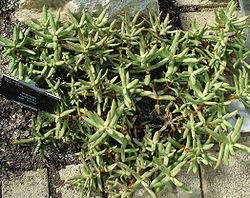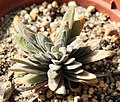| Crassula | |
|---|---|
 | |
| Crassula capitella | |
| Scientific classification | |
| Kingdom: | Plantae |
| Clade: | Tracheophytes |
| Clade: | Angiosperms |
| Clade: | Eudicots |
| Order: | Saxifragales |
| Family: | Crassulaceae |
| Subfamily: | Crassuloideae |
| Genus: | Crassula L. [1] |
| Type species | |
| Crassula perfoliata L. | |
| Diversity | |
| c. 250 species | |
| Synonyms [1] | |
List
| |
Crassula is a genus of succulent plants containing about 200 accepted species, [1] including the popular jade plant ( Crassula ovata ). They are members of the stonecrop family (Crassulaceae) and are native to many parts of the globe, but cultivated varieties originate almost exclusively from species from the Eastern Cape of South Africa. [2] [3]
Contents
- Taxonomy
- Etymology
- Selected species
- List of selected cultivars
- Gallery
- References
- Bibliography
- External links
Crassulas are usually propagated by stem or leaf cuttings. Most cultivated forms will tolerate some small degree of frost, but extremes of cold or heat will cause them to lose foliage and die.




























